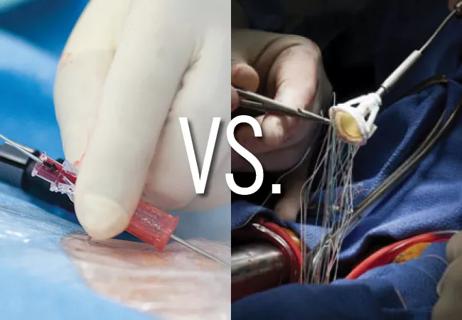Advertisement
Genetic conditions require multidisciplinary care

By Douglas Rogers, MD, chairman of Pediatric Endocrinology and Peter Aziz, MD
Advertisement
Cleveland Clinic is a non-profit academic medical center. Advertising on our site helps support our mission. We do not endorse non-Cleveland Clinic products or services. Policy
Cleveland Clinic offers two multidisciplinary clinics for children and adults with hyperlipidemia and arrhythmias, two genetic conditions requiring special expertise to diagnose and manage.
When a defective gene causes hyperlipidemia, no amount of diet and exercise will lower cholesterol levels enough to protect against a cardiovascular event. These children and their families may benefit from screening and treatment by the pediatric endocrinologist and adult cardiologist in the Familial Hyperlipidemia Clinic.
“Few parents of children with hypercholesterolemia know their cholesterol levels, but in most cases, a parent has dyslipidemia, too,” says Douglas Rogers, MD, chairman of Pediatric Endocrinology.
Any child age 2 or older with a family history of dyslipidemia or premature heart attack (males prior to age 55, females prior to age 65), or a parent with LDL-C levels greater than 240 mg/dL or a medical condition such as diabetes, hypertension, lupus, chronic liver or kidney disease, chronic treatment with glucocorticoids or sirolimus or history of organ transplantation, is at risk and should have a lipid screening.
Any child between the ages of 9 and 11 (pre-pubescent) with a LDL-C greater than 130 mg/dL, a total-C minus HDL-C over 160 mg/dL or a fasting triglyceride level over 400 mg/dL should be referred, he says.
Hyperlipidemia is treated first with diet modification. Statins may be prescribed to children over age 10. In very rare cases of extremely high LDL, plasmapheresis may be advised.
High triglyceride levels and mixed hyperlipidemia are treated primarily with dietary changes and additional exercise.
A referral to the Familial Hyperlipidemia Clinic can be made by calling 216.444.9353.
Pediatric electrophysiologists, adult electrophysiologists and geneticists in the Inherited Arrhythmia Clinic provide comprehensive care to patients with electrical abnormalities including long-QT syndrome, Brugada syndrome and catecholaminergic polymorphic ventricular tachycardia (CPVT).
Their goal is to identify at-risk children and institute preventive measures designed to avoid sudden cardiac death. When an inherited arrhythmia is confirmed, the entire family is screened and treated, as appropriate.
“If a parent has an abnormality, there is often a 50 percent chance each child will have it,” says pediatric electrophysiologist Peter Aziz, MD.
A history of sudden death in a family member, exertional syncope or a personal history suggestive of arrhythmia should prompt a referral.
Treatment may include medication, trigger avoidance or an implantable cardioverter defibrillator.
Because long QT syndrome and CPVT are catecholamine-dependent,sports participation may need to be restricted. However, “some children who are adherent to treatmentand have appropriate safety mechanisms in place can play sportssafely,” says Dr. Aziz.
Advertisement
A referral to the Inherited Arrhythmia Clinic can be made by calling 216.444.4735.
Cleveland Clinic offers two multidisciplinary clinics for children and adults with hyperlipidemia and arrhythmias, two genetic conditions requiring special expertise to diagnose and manage.
When a defective gene causes hyperlipidemia, no amount of diet and exercise will lower cholesterol levels enough to protect against a cardiovascular event. These children and their families may benefit from screening and treatment by the pediatric endocrinologist and adult cardiologist in the Familial Hyperlipidemia Clinic.
“Few parents of children with hypercholesterolemia know their cholesterol levels, but in most cases, a parent has dyslipidemia, too,” says Douglas Rogers, MD, chairman of Pediatric Endocrinology.
Any child age 2 or older with a family history of dyslipidemia or premature heart attack (males prior to age 55, females prior to age 65), or a parent with LDL-C levels greater than 240 mg/dL or a medical condition such as diabetes, hypertension, lupus, chronic liver or kidney disease, chronic treatment with glucocorticoids or sirolimus or history of organ transplantation, is at risk and should have a lipid screening.
Any child between the ages of 9 and 11 (pre-pubescent) with a LDL-C greater than 130 mg/dL, a total-C minus HDL-C over 160 mg/dL or a fasting triglyceride level over 400 mg/dL should be referred, he says.
Hyperlipidemia is treated first with diet modification. Statins may be prescribed to children over age 10. In very rare cases of extremely high LDL, plasmapheresis may be advised.
High triglyceride levels and mixed hyperlipidemia are treated primarily with dietary changes and additional exercise.
A referral to the Familial Hyperlipidemia Clinic can be made by calling 216.444.9353.
Pediatric electrophysiologists, adult electrophysiologists and geneticists in the Inherited Arrhythmia Clinic provide comprehensive care to patients with electrical abnormalities including long-QT syndrome, Brugada syndrome and catecholaminergic polymorphic ventricular tachycardia (CPVT).
Their goal is to identify at-risk children and institute preventive measures designed to avoid sudden cardiac death. When an inherited arrhythmia is confirmed, the entire family is screened and treated, as appropriate.
“If a parent has an abnormality, there is often a 50 percent chance each child will have it,” says pediatric electrophysiologist Peter Aziz, MD.
A history of sudden death in a family member, exertional syncope or a personal history suggestive of arrhythmia should prompt a referral.

Anastasia (right) and Giavonna (left) Dilts have normal cholesterol levels after years of management in Cleveland Clinic’s Familial Hyperlipidemia Clinic. Their father had suffered a myocardial infarction in his late 20s, and Anastasia’s total and LDL cholesterol levels rose to 290 and 236 mg/dL before her third birthday.
Advertisement
Treatment may include medication, trigger avoidance or an implantable cardioverter defibrillator.
Because long QT syndrome and CPVT are catecholamine-dependent,sports participation may need to be restricted. However, “some children who are adherent to treatmentand have appropriate safety mechanisms in place can play sportssafely,” says Dr. Aziz.
A referral to the Inherited Arrhythmia Clinic can be made by calling 216.444.4735.
Advertisement
Advertisement

Cleveland Clinic series supports its feasibility, especially with HeartMate 3

Questions remain following late mortality signal from a retrospective cohort study

TAVR explant demands multidisciplinary expertise

How two of our surgeons are working for care equity, greater representation in research and practice

Judicious application yields a 99.7% repair rate and 0.04% mortality

Studies reveal increased cardiac events, enhanced platelet reactivity and thrombotic potential

Large single-center series demonstrates safety and efficacy for extending procedure

Eminent clinician-researcher brings special expertise in nutritional interventions for heart failure